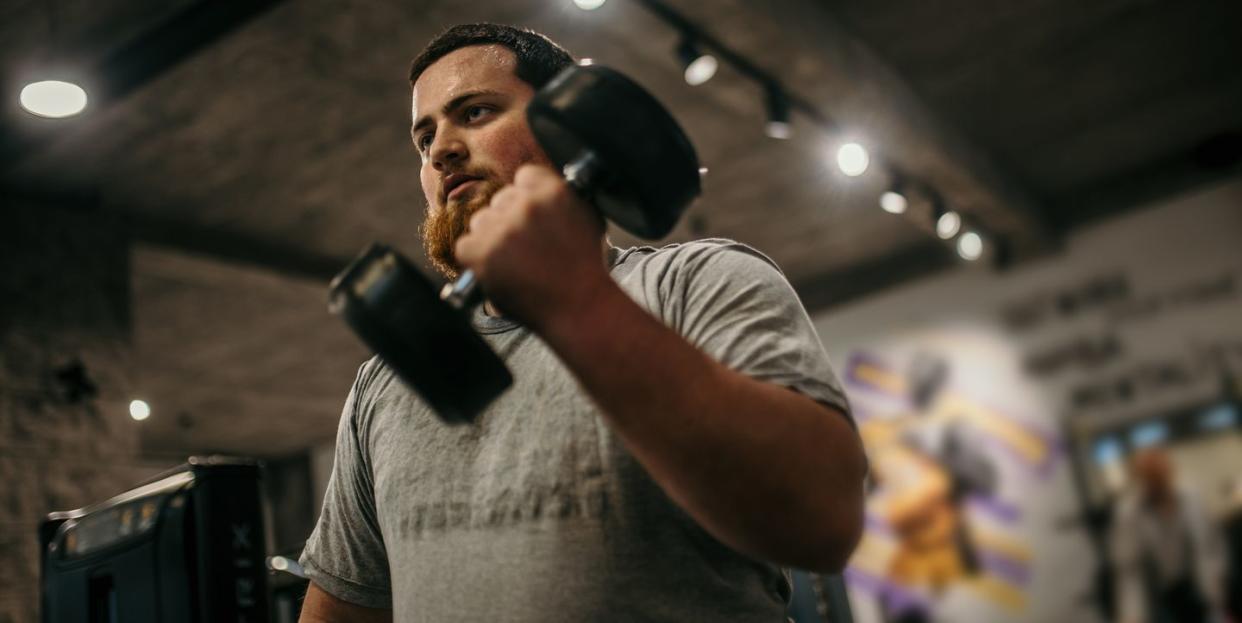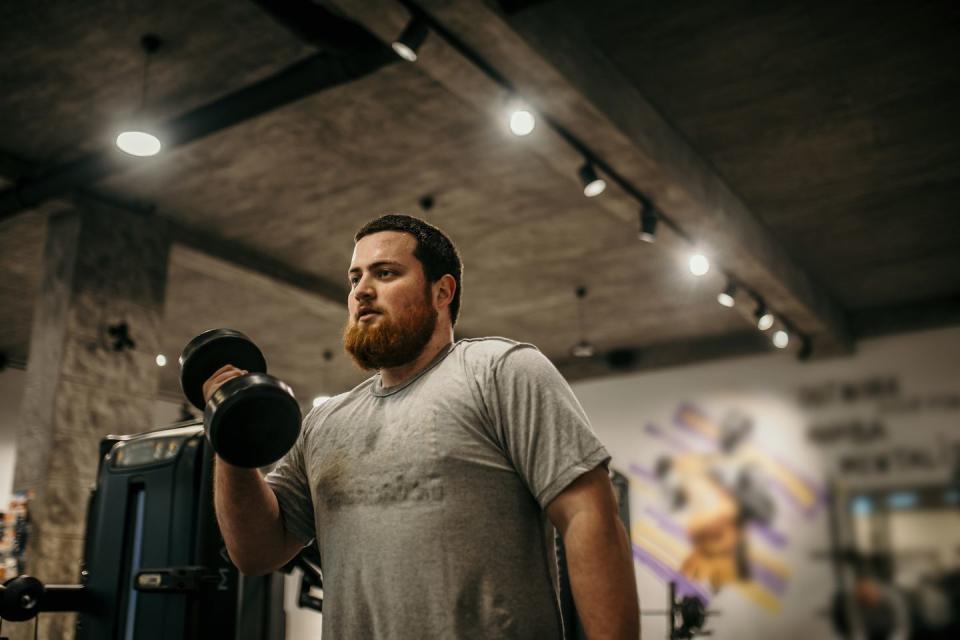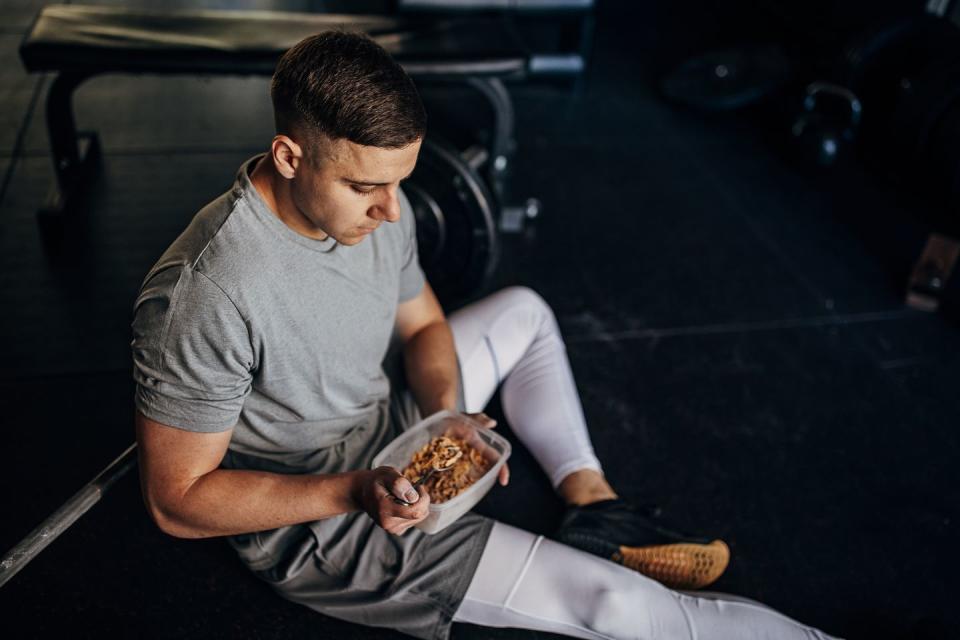Can You Actually Burn Fat and Gain Muscle at the Same Time?

IF YOU'RE LOOKING to get in shape, your goals probably boil down to achieving two specific things: losing fat and gaining muscle.
Achieving just one of these is no small feat. Achieving them together is a whole different ballgame. This is called "body recomposition" by scientists and fitness professionals—in other words, the process of changing the composition of your body by lowering body fat mass and increasing muscle mass.
The biggest hurdle you'll have to clear on your journey to accomplishing these goals is that they require largely different demands. To lose fat, you need to be burning more calories then you're taking in. To build muscle, you need to increase your protein intake and prioritizing strength training, so your body can build more muscle fibers. Eager to make big changes, people often try to achieve both at the same time. Is it even possible to both lose fat and gain muscle simultaneously? We asked the experts.
Can You Burn Fat And Build Muscle at the Same Time?
A 2020 meta-data analysis from the Strength and Conditioning Journal suggests that it may be possible to lose fat mass and gain muscle at the same time. There's one issue with this, however—all of the studies compiled for the report were based on small samples of young athletes, lacking an inclusive sample population. Further research needs to be conducted to understand exactly how body recomposition happens to different types of subjects, and if these results are applicable to different demographics.
Though burning fat and building muscle concurrently may be possible, it's not necessarily optimal, says Lee Boyce, C.S.C.S., an MH Advisory Board member. He warns that aiming for both at the same time may cause a slower rate of change for both goals to be reached.
A more effective approach is to prioritize one goal before the other, specifically muscle building over fat loss. The good news is, emphasizing muscle building will spark some habits and physiological responses that may help burn away some unwanted fat.
If someone focuses on building muscle first, "the byproduct of that would be trigger[ing] some fat loss," Kurt Ellis, N.S.C.A., of Beyond Numbers Performance, says. "It's going to enable you to build habits that are going to be a lot more favorable for you long term."
Building muscle mass results in an increased metabolic rate, meaning the body will burn more calories, since it takes more energy to maintain muscle tissue than adipose tissue (a.k.a. body fat). For example, assume you and your gym partner at the same height and weight. You have a body fat percentage of 10 percent, and theirs is 20 percent. On any given day where you both move the same amount, you will likely burn more calories than they will (assuming, too, that neither of you have any other health problems that may effect your metabolism).
If you follow the right steps, focusing on muscle building may help to bring about the fat loss you're also looking for even more quickly.
3 Tips for Losing Fat and Gaining Muscle
Prioritize Strength Training

To gain muscle, you need to be incorporating resistance training into your exercise routine. This puts your muscles under tension, creating micro-tears in the muscle, which your body will then repair by creating more fibers. As we've already established, you need to be burning calories to lose fat. Luckily, strength training does both of those things. Yes, cardio may burn more calories, but too much can jeopardize your gains.
For longevity, focus on strength training with smaller bits of low intensity cardio to achieve muscle building. At the end of the day, you're still burning calories, which is what you need to lose fat mass.
Protein, Protein, Protein

You've probably been preached at by some muscle-bound bro about the importance of protein. It's not just hype—protein is the building block of muscle tissue and deserves its praise. If you don't have enough, your muscles may begin to break down. This is especially important to consider when you're in a calorie deficit. Limiting calories is the key to fat loss—but if you also limit your protein, you'll lose your muscle mass, says Boyce.
"If you want to be adding muscle without adding too much weight, you can't be in a surplus to do it," Boyce says. "So, the challenge is creating that [low] calorie intake, but modifying the nutrient choices that are going to make up those calories."
Make high protein food sources a bigger staple in your nutrition plan. Boyce suggests aiming to consume at least 1 gram of protein per pound of your body weight. Do this with real food sources as much as possible, and make up the difference with supplements.
Recovery is Key

Beware of coming on too hard, too fast when starting a fitness routine. Overtraining can lead to injury, which could take you out of the gym all together. That's why prioritizing recovery is important if you're trying to burn fat and gain muscle, Ellis says. Recovery allows the body time to repair itself after intense workouts, so don't neglect your rest day.
Proper rest also means proper sleep, Ellis says. A 2020 study published in the Medicine & Science in Sport and Exercise journal found that lack of sleep led to a lower release of cytokines—the proteins that build up our muscles.
Best Workouts for Losing Fat and Gaining Muscle
We already know that it's best to prioritize strength workouts to be able to gain muscle and lose fat. The most effective way to do both is to anchor those workouts with big, multi-joint movements, such as squats, deadlifts, and presses.
"Compound lift movements incorporate ton of muscles. You need to recruit a decent amount in order to elicit that hypertrophy response," Ellis says. More muscle recruitment also means more calorie burn—a win for fat loss.
That doesn't mean you need to do the same barbell squats and dumbbell RDLs every time you go to the gym. There are tons of variations of these compound movements you can incorporate that will keep your routine fresh.
You can train with full-body splits, use a strategy like a push-pull-legs split (like this one), or work alternating between your upper body and lower body. This way, on the day that you're working your upper body, your lower body is resting. This creates an efficient system so that you're able to hit a higher volume of reps and sets without running the risk of overtraining, since Boyce says you'll be better able to tackle more workouts safely with the built-in rest.
You Might Also Like

